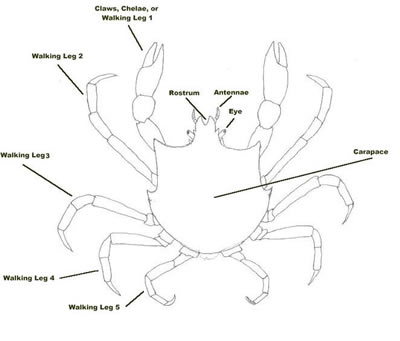

INFRAORDER BRACHYURA (TRUE CRABS) OF
BRITISH COLUMBIA
(Order Decapoda)
This infraorder contains the well-known Dungeness and Tanner crabs. They can be separated from the very similar king crabs because true crabs have the fifth pair of walking legs well developed (they are usually smaller than the other legs, but not hidden away like in the king crabs). I quick way I use to separate them is to look at the eyes from above. In true crabs the larger pair of antennae are between the eye sockets while in king crabs they are outside the eye sockets. To date approximately 35 species of true crab are recorded from BC. True crabs are organized into many superfamilies, with seven found in British Columbia.

Brachyura morphology, illustration by Aaron Baldwin
One of the largest superfamilies, the Majoidea or spider crabs are particularly well-represented. This group includes the commercially important Tanner crab and snow crabs as well as the fascinating decorator and kelp crabs. Spider crabs, as their name implies, typically have very long, skinny legs giving them a spider-like appearance. The largest arthropod in the world, the Japanese spider crab, is a Majoid and reaches about 4 meters across in leg span! Another feature of this group is having the rostrum ("nose") bifid or forked into two sections. Spider crabs differ from most crabs in that they cease growing after a "terminal molt" stage is reached (most crabs grow throughout their lives although molting become less frequent with age).
Another well-represented group in the north Pacific is the Cancroidea. This Superfamily includes the unusual helmet crab and the commercially important Dungeness crab (Cancer magister). Two other species, the red rock crab (Cancer productus) and the spot-bellied rock crab (Cancer antennarius) grow to a large enough size to make them worth eating and form a portion of the sport harvest. The cancer crabs tend to be fairly aggressive predators and will eat (or attempt to) nearly anything that they can capture. They are especially adept at opening mollusk shells, using their claws like a can opener to crack even the thickest snail shells.
Less well known but very diverse are the Pinnotheroidea or pea crabs. Members of this group are nearly always associated with other invertebrates. Clam diggers commonly encounter the gaper pea crabs (Pinnixa littoralis and Pinnixa faba) when shucking horse clams. Others live in mud shrimp burrows, worm tubes, in sea squirts, on burrowing brittle stars, etc. These crabs are usually very small and are often white colored.
The grapsoid or shore crabs are extremely common in most areas. Turning over mid to upper intertidal rocks commonly exposes colonies of these crabs. The green shore crab, Hemigrapsus oregonensis, likes muddy areas and can tolerate a wide range of salinities. It can sometimes be found in nearly fresh water estuaries and marshes.
The remaining groups are represented by a single species each in British Columbia. They all represent groups that have abundant tropical representatives. The xanthoid or black-clawed crabs are represented by a single species with two subspecies. They are related to the Florida stone crab, a commercially important species. The calappoid or shame-faced crabs are also much more diverse in warmer waters. The invasive green crab (Carcinus maenus) is the only local member of the Portunoidea, the swimming crabs. The extremely important blue crab, Callianectes sapidus, is the target of an enormous fishery on the Atlantic coast. The green crab, originally from Europe, is very destructive to other invertebrates and is being watched very closely as it expands its range.
Please cite these pages as:
Author, date, page title. In: Klinkenberg, Brian. (Editor) 2023. E-Fauna BC: Electronic Atlas of the Fauna of British Columbia [www.efauna.bc.ca]. Department of Geography, University of British Columbia, Vancouver. [Date Accessed]
© Copyright 2023 E-Fauna BC.